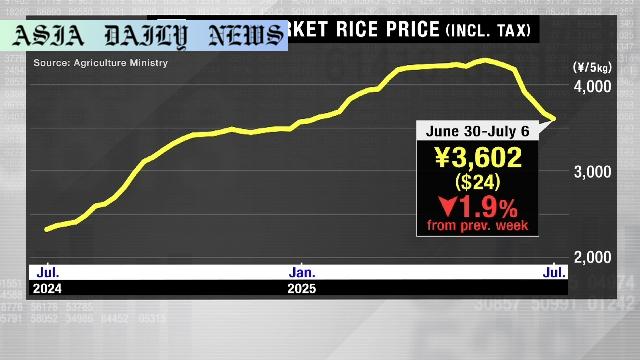Rice Prices: The average price of rice at supermarkets in Japan has declined for a seventh consecutive week but remains elevated compared to last year.
Supermarket rice prices in Japan have fallen for the seventh straight week.
Average price per 5-kilogram bag is 3,602 yen, down by 1.9%.
Prices remain 54.8% higher than a year ago, reflecting past shortages.
Blended rice varieties, mixed with stockpiled grains, widen price differences.

The Decline in Supermarket Rice Prices
The recent trend of declining supermarket rice prices in Japan marks a significant shift in consumer behavior and market dynamics. For seven straight weeks, the price of a 5-kilogram bag of rice has dropped consistently, with the most recent survey showing a 1.9% decrease from the previous week. This downward trend reflects an increased use of government stockpiled grains by consumers opting for affordable options in the face of economic challenges. However, this positive trend is overshadowed by the stark reality that rice prices are still significantly higher than they were a year ago. A 54.8% annual increase indicates how prior shortages and supply chain dynamics have left a lasting impact on the market.
Factors Behind the Pricing Shift
A closer look reveals the dynamics at play behind the fluctuating rice prices in Japan. The government has been making stockpiled grains available to hold prices steady, and this policy has encouraged consumers to choose blended rice varieties over more expensive single-brand options. These efforts have widened the pricing gap between blended products containing stockpiled grains and premium single-brand varieties. The market is responding to these broader choices, showcasing how pricing flexibility can impact consumer purchasing power significantly during inflationary periods.
Wider Implications for the Economy
Despite the recent reductions, the persistence of heightened rice prices compared to the previous year is a reminder of how fragile the agricultural and food supply chain can be. It also exemplifies the challenges economies face in balancing staple food affordability without compromising the livelihoods of producers. Consumers navigating these price adjustments reveal that affordability remains a key priority, highlighting ongoing economic pressures across households in Japan.
Future Predictions for Rice Pricing
Looking ahead, there is cautious optimism about further easing in rice prices due to increased reliance on government stockpiles and stable supply conditions. However, external factors such as global supply chain disruptions, climate-related challenges to agriculture, and fluctuations in the yen’s value may still influence price trends. Policymakers and stakeholders must work collaboratively to ensure pricing stability, which is crucial to maintaining food security without compromising the quality of staple grains like rice.



Commentary
The Importance of Stable Rice Prices
As a staple food item, rice holds immense cultural and economic significance in Japan. The recent decline in its price at supermarkets is undoubtedly a welcome sign amidst inflationary pressures. However, it’s essential to take a nuanced look at the factors driving this trend and what it means for both consumers and the agricultural sector.
Consumer Shifts Highlight Economic Pressures
The steady availability of government-stocked grains has provided a much-needed reprieve for consumers grappling with rising costs. It is, however, a double-edged sword. While this move addresses immediate affordability issues, it raises questions about market reliance on government intervention. Many low-income households are opting for lower-priced, blended varieties instead of premium single-origin brands. This points to purchasing priorities shifting firmly towards affordability during times of prolonged economic strain.
Future Outlook for Agriculture
For rice producers, the declining market price is a dilemma. On the one hand, reduced prices might boost sales volume, but it can also affect overall revenue and profitability. Balancing consumer relief and protecting farmers’ economic interests will be critical. Another challenge lies in unpredictable factors such as climate change and international trade policies, both of which could disrupt agricultural output and pricing stability.
Collaborative Efforts Needed
It is evident that coordinated efforts between the government, producers, and retailers are essential to manage a sustainable future for rice production and consumption. Policies that stabilize supply and pricing, while supporting farmers, could pave the way for long-term resilience in the rice market.